341 results
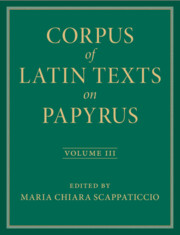
Corpus of Latin Texts on Papyrus
- Coming soon
-
- Expected online publication date:
- January 2025
- Print publication:
- 31 January 2025
-
- Book
- Export citation
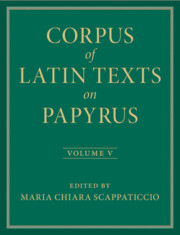
Corpus of Latin Texts on Papyrus
- Coming soon
-
- Expected online publication date:
- January 2025
- Print publication:
- 31 January 2025
-
- Book
- Export citation
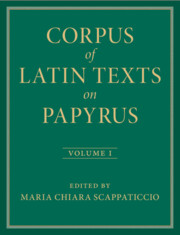
Corpus of Latin Texts on Papyrus
- Coming soon
-
- Expected online publication date:
- January 2025
- Print publication:
- 31 January 2025
-
- Book
- Export citation
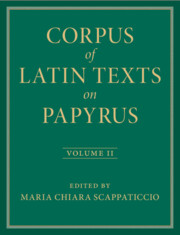
Corpus of Latin Texts on Papyrus
- Coming soon
-
- Expected online publication date:
- January 2025
- Print publication:
- 31 January 2025
-
- Book
- Export citation
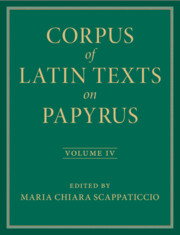
Corpus of Latin Texts on Papyrus
- Coming soon
-
- Expected online publication date:
- January 2025
- Print publication:
- 31 January 2025
-
- Book
- Export citation
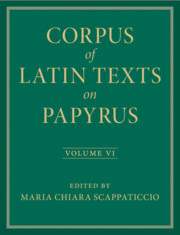
Corpus of Latin Texts on Papyrus
- Coming soon
-
- Expected online publication date:
- January 2025
- Print publication:
- 31 January 2025
-
- Book
- Export citation
Abbreviations
-
- Book:
- Latin Loanwords in Ancient Greek
- Published online:
- 25 May 2023
- Print publication:
- 15 June 2023, pp 665-680
-
- Chapter
- Export citation
8 - When were loanwords used?
-
- Book:
- Latin Loanwords in Ancient Greek
- Published online:
- 25 May 2023
- Print publication:
- 15 June 2023, pp 571-594
-
- Chapter
- Export citation
Index locorum
-
- Book:
- Latin Loanwords in Ancient Greek
- Published online:
- 25 May 2023
- Print publication:
- 15 June 2023, pp 704-706
-
- Chapter
- Export citation
Index of Latin words
-
- Book:
- Latin Loanwords in Ancient Greek
- Published online:
- 25 May 2023
- Print publication:
- 15 June 2023, pp 707-732
-
- Chapter
- Export citation
Contents
-
- Book:
- Latin Loanwords in Ancient Greek
- Published online:
- 25 May 2023
- Print publication:
- 15 June 2023, pp vii-x
-
- Chapter
- Export citation
11 - Overall conclusions and remaining questions
-
- Book:
- Latin Loanwords in Ancient Greek
- Published online:
- 25 May 2023
- Print publication:
- 15 June 2023, pp 651-654
-
- Chapter
- Export citation
9 - Where were loanwords used?
-
- Book:
- Latin Loanwords in Ancient Greek
- Published online:
- 25 May 2023
- Print publication:
- 15 June 2023, pp 595-622
-
- Chapter
- Export citation
3 - Lexicon
-
- Book:
- Latin Loanwords in Ancient Greek
- Published online:
- 25 May 2023
- Print publication:
- 15 June 2023, pp 20-502
-
- Chapter
- Export citation
Dedication
-
- Book:
- Latin Loanwords in Ancient Greek
- Published online:
- 25 May 2023
- Print publication:
- 15 June 2023, pp v-vi
-
- Chapter
- Export citation
2 - The parameters of this study
-
- Book:
- Latin Loanwords in Ancient Greek
- Published online:
- 25 May 2023
- Print publication:
- 15 June 2023, pp 5-19
-
- Chapter
- Export citation
6 - Which Latin suffixes were borrowed into Greek?
-
- Book:
- Latin Loanwords in Ancient Greek
- Published online:
- 25 May 2023
- Print publication:
- 15 June 2023, pp 543-556
-
- Chapter
- Export citation
1 - Introduction
-
- Book:
- Latin Loanwords in Ancient Greek
- Published online:
- 25 May 2023
- Print publication:
- 15 June 2023, pp 1-4
-
- Chapter
- Export citation
Frontmatter
-
- Book:
- Latin Loanwords in Ancient Greek
- Published online:
- 25 May 2023
- Print publication:
- 15 June 2023, pp i-iv
-
- Chapter
- Export citation
12 - Appendices
-
- Book:
- Latin Loanwords in Ancient Greek
- Published online:
- 25 May 2023
- Print publication:
- 15 June 2023, pp 655-664
-
- Chapter
- Export citation



